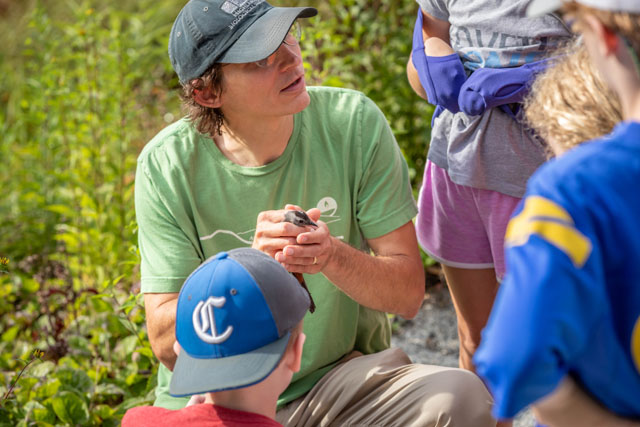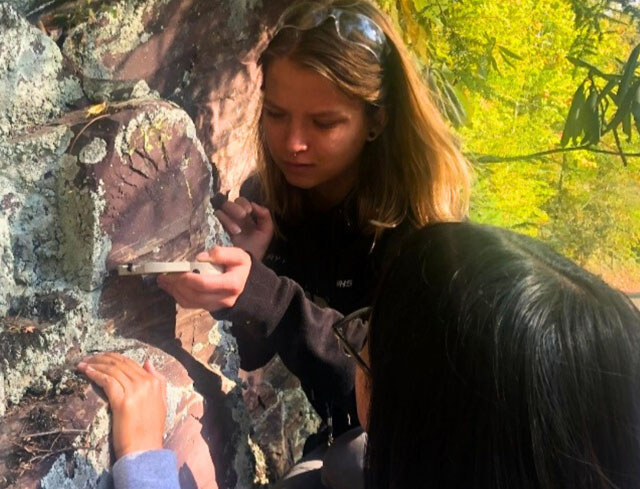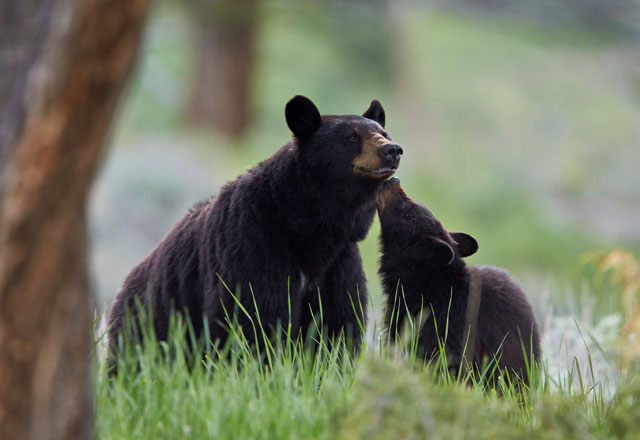A Bird’s Eye View
02 Aug 2023
Tracking Birds with the Highlands Biological Station
By BRENDON VOELKER

Standing atop the granite cliffs of Whiteside Mountain, most are there to enjoy its commanding and expansive views reaching far into Georgia and South Carolina. In the valley below, residents in large estates or quaint cottages and visitors alike enjoy the view looking up at the 1,000-foot dome. Others enjoy the large swaths of wilderness nearby. But these cliffsides, bogs, and diverse forests hold a different reward, one with wings. Since 2020, the Highlands Biological Station (HBS) has been working tirelessly with other partnering organizations to survey birds, a project that has become a cornerstone of their work. This work is possible thanks to funding through the Highlands Biological Foundation.
The program, named “Monitoring Avian Productivity and Survivorship,” or MAPS for short, was founded in the 90’s and now includes hundreds of organizations that participate around the country. The HBS also provides educational courses and bird banding demonstrations to other local organizations such as schools and nonprofits, and the HBS partners with both local and national organizations in numerous ways. One such partnering organization is the Highlands-Plateau Audubon Society, which has the mission “to provide opportunities to enjoy and learn about birds and other wildlife and to promote conservation and restoration of the habitats that support them.”
Though the HBS was originally founded as a non-profit, the facility was transitioned into the University of North Carolina System in 1976 and in 2018 became a multi-campus center of Western Carolina University. Much of the HBS research is now funded by the Highlands Biological Foundation (HBF). Associate Director of the HBS Jason Love and Winter Gary, Marketing Manager for the HBF, took time to elaborate on how bird banding works, as well as their passion for what they do. Jason holds an expansive and diverse resume with a BS in Forest Resources from UGA and a MS in Wildlife and Fisheries Management from West Virginia University. Winter holds BS degrees in Environmental Science and Psychology from UNC Chapel Hill and has been with HBF since 2019.
Situated on the southernmost end of the Appalachian Mountains, the plateau is an ideal area to observe migrating species, such as Canada Warblers. Nearby Panthertown Valley, due east, has also been described as one of the best places to observe similar species. The variety of what’s captured and observed is captivating to even longtime residents.
While the area is also home to a population of kestrels (the smallest falcon in North America) and peregrines (the fastest animal on the planet), neither are commonly captured due to their larger sizes. More commonly trapped species include the warblers, thrushes and sparrows, among many others.
The method of capturing these birds is both peculiar and delicately managed, including a team of up to four summer research assistants, Jason, and two or more members of the Blue Ridge Bird Observatory, a local non-profit focused on avian research and conservation. Traps consist of fine mesh nets, known as mist nets that have been specifically developed for the safe capture of birds. The nets are 30 feet long, 10 feet high, and are deployed 30 minutes before sunrise. They are then checked every 30 minutes throughout the morning before being removed around noon.
Birds are expertly removed from the nets, ensuring they receive no harm. Once at the banding table, researchers carefully place a tiny aluminum band with its own unique ID number around the leg of the bird. After banding, researchers continue to collect biological data on the bird such as age, sex, feather condition, wing measurements, and any signs of disease or injury. Even better, if you visit HBS in the morning and notice researchers working on the project, they welcome you to observe. They describe it as “an excellent opportunity to engage in real and relevant science in our community.”
This year the researchers are working with the Southeastern Cooperative Wildlife Disease Study, which is like the CDC for wildlife, collecting ticks from the birds they have in hand. In particular, they are looking for the Asian Longhorned Tick, a species first found in North America in 2017. They are trying to understand how prevalent this tick is and which species of birds may serve as hosts for this uninvited parasite.
This type of long-term monitoring allows researchers to track the health and fitness of birds during a time when there is increased “suburbanization of the mountains,” which can impact bird communities. After the bird banding session is over, undergraduate researchers from WCU and UNC-Chapel Hill conduct surveys of insects on branches of trees and shrubs as part of the CaterpillarsCount! project. This project aims to detect trends in insect abundance, particularly caterpillars, which are a primary food source for hatchlings and fledgling birds. Climate change can result in earlier spring green-up, causing these insects to peak earlier. But most migrating songbirds nest at the same time every year, so an earlier spring means there is less food available when the birds hatch, leading to lower nestling survival.
Both Jason and Winter have a true passion for what they’re helping support, and it’s evident within seconds of speaking to them. Just last year, Jason helped catch a Pileated Woodpecker, the largest woodpecker species in our region. It’s also quite loud and dangerous to handle without proper training, he notes. “It’s a little bit like fishing, you never know what you’re going to catch,” he continued.
Bird banding also helps track threats to our bird population, including disease, invasive exotic plants, and climate change. The invasive plants include Japanese Knotweed, Oriental Bittersweet, Multiflora Rose, Kudzu, English Ivy, and others. These plants smother out native plants. In addition, few if any caterpillars in this region have evolved to feed upon them, meaning these plants produce little food for birds. In recent years, many invasive removal projects have appeared in the region with the help of local non-profits such as the Highlands-Cashiers Land Trust, Highlands Biological Station, and the Highlands Audubon Society. In recent years, the push to consider native plants when gardening has grown tremendously.
Whether you’re local or just visiting, HBS encourages you to come by and observe the process during one of their scheduled events. For 2023, the program was titled “A Bird's Eye View: See Bird Research in Action!" with banding running from June to August. An events page on their website also has information on their many programs. Other events hosted by HBS include an array of tours, with some focusing on bog gardens, old growth forests, pollinator gardens, and more. A variety of carnivorous plants are also cared for on-site in their bog garden.
Located just moments from downtown Highlands, HBS makes for an excellent destination for any visitor or resident of the plateau. A vast array of resources are also available through the organization and easily accessible on their website. Both the Nature Center and Botanical Gardens are open to the public, with more campus information available at highlandsbiological.org.
The Botanical Gardens is open seven days a week from dusk to dawn, and the adjacent Nature Center is open seasonally. While the bird banding program only occurs a handful of days a year, Winter notes how, following this bird banding season, “the foundation will have funded just shy of $20,000 into the program.” Most of the participating organizations are also located in remote areas, making Highlands an ideal destination for the program.
Whether you are a bird aficionado or simply want to learn more, be sure to plan a stop at HBS. They have something to offer everyone in the family.













